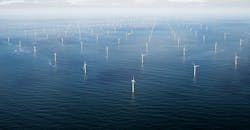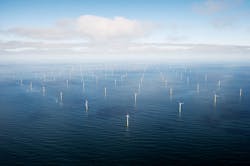A wind power turbine began to turn last month above the waves in the North Sea 120 km (about 75 miles) off the U.K.’s Yorkshire Coast, the first of 174 Siemens Gamesa 7MW turbines that will make up the world’s largest offshore wind generation facility, Hornsea 1.
Under development by Danish power company Ørsted A/S and Global Infrastructure Partners, Hornsea 1 is expected to be completed in the first quarter of 2020 and will produce 1,200MW of power, nearly double the size of the current largest offshore wind farm, Walney Extension in the Irish Sea, and capable of powering well over one million U.K. homes with renewable electricity. According to the plan, Hornsea 1 will be surpassed by the second phase, Hornsea 2, which will produce 1,386MW beginning in 2022, and Hornsea 3, with an estimated maximum capacity of 2,400MW, slated for construction in 2022 to 2025.
“Hornsea 1 is the first of a new generation of offshore power plants that now rival the capacity of traditional fossil fuel power stations,” Matthew Wright, U.K. managing director at Ørsted, said in a press release. “The ability to generate clean electricity offshore at this scale is a globally significant milestone.”
To date, 172 out of 174 monopile foundations have been installed at Hornsea 1, and turbine installation is expected to continue until late summer 2019. The electricity generated by the turbines will pass via undersea cables through one of three massive offshore substations, and the world’s first offshore reactive compensation station, all fully installed, before reaching shore at Horseshoe Point, Lincolnshire. The electricity is then transported via underground cables to the onshore substation in North Killingholme, where it connects to the U.K. National Grid, in order to reach well over one million homes in the United Kingdom.
As Hornsea 1 becomes operational, it shows the maturation of offshore wind development globally and shines a light on the relative youth of offshore wind in the United States. Here, things are just getting started, and a recent flurry of activity by government entities and businesses specializing in offshore wind suggests the U.S. market may come to life fairly quickly.
The potential for offshore wind in the United States is significant. According to the DOE’s Office of Energy Efficiency and Renewable Energy (EERE), data on the technical resource potential suggest more than 2,000 GW could be accessed in state and federal waters along the coasts of the United States and the Great Lakes.
In December, the United States finalized the sale of leasing rights on 390,000 acres of federally owned waters off Rhode Island and Martha’s Vineyard, the largest-ever sale of offshore wind development rights in the United States. With 11 companies bidding on the leases, three developers — Equinor, Vineyard Wind, and Mayflower Energy — won the rights and paid a total of $405.1 million.
Most of the early U.S. offshore wind development activity is happening in the Northeast because the shallower water and strong winds make development more attractive and economical, for now, according to the U.S. Department of Interior’s Bureau of Ocean Energy Management (BOEM). Wind speeds off the Southern Atlantic Coast and in the Gulf of Mexico are lower than wind speeds off the Pacific Coast. Hawaii has the highest estimated potential, accounting for roughly 17% of the entire estimated U.S. offshore wind resource, according to the BOEM.
The Block Island Wind Farm, with five turbines producing 30MW about four miles off Rhode Island’s Block Island, is the first commercial offshore wind farm in U.S. waters. It was developed by Deepwater Wind and became operational in December 2016. Ørsted acquired Deepwater Wind in a deal announced last August for $510 million.
Vineyard Wind is set to be the first utility-scale offshore wind farm in the United States. Sited in a 160,000-acre area south of Martha’s Vineyard off the Massachusetts coast, Vineyard Wind has been working through the permitting process since 2011 and is expected to begin construction this year.
The wind farm will feature 84 of the world’s largest wind turbines, units capable of producing 9.5MW each. “With this turbine model, Vineyard Wind is able to reduce the total number of turbines for the project from 106 to 84 while at the same time decreasing the project’s footprint by more than 20%,” said a Vineyard Wind release.
Bigger is better in the world of wind turbines because the larger the area swept by the blades, the more power the turbine can generate, and the higher the blades reach into the atmosphere the more they can access stronger, steadier winds aloft. This allows the turbine to produce closer to its nameplate capacity, improves efficiency, and makes it easier to integrate its production into the power grid.
A pair of undersea substations to be installed about 34 miles south of the Massachusetts mainland will connect Vineyard Wind’s turbines via undersea transmission cable to landfall on Cape Cod and a switching station in Barnstable, and from there to the New England power grid.
The most remarkable thing about Vineyard Wind isn’t its size or scope or the fact that it’s a first for the United States, observed a recent article in IEEE Spectrum, it’s the price that Vineyard Wind has agreed to charge for the wind farm’s electricity: 7.4 cents per kilowatt-hour. “In the project’s second phase, the price will drop to just 6.5 cents [cents per kilowatt-hour], making it competitive with coal and natural gas but without the carbon emissions. For comparison, electricity from the tiny five-turbine, 30MW Block Island wind farm … is priced at 24.4 cents per kilowatt-hour.”
As offshore wind power pricing becomes competitive with conventional power generation, many coastal jurisdictions are embracing offshore wind. Rhode Island, Massachusetts, Virginia, Maryland, New Jersey, New York, and North Carolina all have offshore leases on the books or in the works, according to data tracked by the BOEM.
New York Governor Andrew Cuomo announced in January that the state will quadruple planned offshore wind development to 9,000MW by 2035. Maryland’s legislature is considering two bills that would triple the offshore wind capacity available for development.
Tying all that power back to the mainland grid is a major undertaking. A consortium formed in 2010, called the Atlantic Wind Connection, that would build a high-capacity undersea transmission system in three phases that would begin in northern New Jersey and eventually extend to southern Virginia, drew backing from powerhouses such as Google but appears to have scaled back its ambitions. Offshore wind developments currently underway rely on individual connections back to shore.
The future of offshore wind development in the United States will depend on further development of technologies suited to North American waters. Powerful offshore winds in the Pacific’s deep waters will require more research in floating offshore wind turbines and the South Atlantic and Gulf of Mexico have researchers searching for structures that can better withstand the area’s hurricanes.
In February, the DOE’s Advanced Research Projects Agency-Energy (ARPA-E) announced it was making available $28 million in funding for research projects to develop new technologies for floating offshore wind turbines. The funding round is part of a new ARPA-E program called ATLANTIS (Aerodynamic Turbines, Lighter and Afloat, with Nautical Technologies and Integrated Servo-control).
Work on floating offshore wind development is getting underway in California. Last April, the Redwood Coast Energy Authority selected a consortium to build an floating offshore wind farm up to 150MW off the coast of Humboldt County, and the Castle Wind project proposed for waters in Morro Bay would include 100 floating turbines with a total generating capacity of 1,000MW.
Anticipating the need for a workforce ready to install, service, and operate large wind farms offshore has spurred interest in training programs.
The University of Delaware last fall announced a partnership with the Energy and Climate Academy of Denmark to create the Offshore Wind Skills Academy. The school will develop a new curriculum to train people for jobs in the wind energy industry with an emphasis on professionals from traditional energy industries, supply chain companies, regulators, the investment community and others.
A subsea cable manufacturer earlier this month signed a memorandum of understanding with Bristol Community College in Massachusetts to provide training for future workers in the U.S. offshore wind industry.
With the burst of activity in the U.S. offshore wind market, along with ongoing expansion globally, electrical contractors are seeing an emerging opportunity to get involved in a new market sector with huge upside potential as renewable energy ambitions move out to sea where the strongest winds blow.

